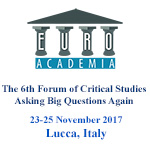Euroacademia Conferences
 Europe Inside-Out: Europe and Europeanness Exposed to Plural Observers (9th Edition) April 24 - 25, 2020
Europe Inside-Out: Europe and Europeanness Exposed to Plural Observers (9th Edition) April 24 - 25, 2020 Identities and Identifications: Politicized Uses of Collective Identities (9th Edition) June 12 - 13, 2020
Identities and Identifications: Politicized Uses of Collective Identities (9th Edition) June 12 - 13, 2020 8th Forum of Critical Studies: Asking Big Questions Again January 24 - 25, 2020
8th Forum of Critical Studies: Asking Big Questions Again January 24 - 25, 2020 Re-Inventing Eastern Europe (7th Edition) December 13 - 14, 2019
Re-Inventing Eastern Europe (7th Edition) December 13 - 14, 2019 The European Union and the Politicization of Europe (8th Edition) October 25 - 26, 2019
The European Union and the Politicization of Europe (8th Edition) October 25 - 26, 2019 Identities and Identifications: Politicized Uses of Collective Identities (8th Edition) June 28 - 29, 2019
Identities and Identifications: Politicized Uses of Collective Identities (8th Edition) June 28 - 29, 2019 The European Union and the Politicization of Europe (7th Edition) January 25 - 26, 2019
The European Union and the Politicization of Europe (7th Edition) January 25 - 26, 2019 7th Forum of Critical Studies: Asking Big Questions Again November 23 - 24, 2018
7th Forum of Critical Studies: Asking Big Questions Again November 23 - 24, 2018 Europe Inside-Out: Europe and Europeanness Exposed to Plural Observers (8th Edition) September 28 - 30, 2018
Europe Inside-Out: Europe and Europeanness Exposed to Plural Observers (8th Edition) September 28 - 30, 2018 Identities and Identifications: Politicized Uses of Collective Identities (7th Edition) June 14 - 15, 2018
Identities and Identifications: Politicized Uses of Collective Identities (7th Edition) June 14 - 15, 2018
Old Masters Exhibitions and Fascist Propaganda: Italian Masterpieces in London, Paris and Belgrade (1930-1938)
-
-

-
Presentation speakers
- Matilde Cartolari, Technische Universitaet von Berlin, Germany
Abstract:
During its totalitarian rule, the Fascist regime frequently promoted exhibitions in order to draw popular consensus within and outside national borders. Italian art, and particularly Renaissance art, represented a model of ideal beauty and unchallenged civilization deeply rooted in European historical consciousness. It offered both images of municipal virtue and national excellence. Artists, patrons and the portrayed men, whether fictitious or historical, conveyed a sense of authority, strength and wisdom. Moreover, flourishing artistic patronage was often associated with the idea of good governance. Thus, Italian art of the past became the mirror of contemporary Fascist Italy and its «New Man», whose ultimate prototype was Mussolini himself. However, as Francis Haskell pointed out, these exhibitions not only contributed to construct Italy’s national identity, but were also part of a wider foreign policy strategy. This paper will investigate the Old Masters exhibitions promoted by the Fascist government during the Thirties, i.e. Italian Art 1200-1900 (London 1930), L’Art Italien de Cimabue à Tiepolo (Paris 1935) and the exhibition of Italian portraits organized in Belgrade in 1938. Italian cultural policy will be considered in relation to its dynamic alliances and rivalries, in order to shed light on the context that involved both physical and symbolical displacements of artworks for propaganda purposes.
-
Related Presentations

Understanding the Trembles of Nature: How Do Disaster Experiences Shape Bank Risk Taking?
- Jaap W. Bos
- Runliang Li

Financial Crises snd Plurilateral Discourses
- Diana Bozhilova

Eternal Rebirth: The Difficult Development of Urban Identity Between Destruction, Reconstruction and New Formal Layouts - The Case of Argenta (Ferrara, Italy)
- Enrico Pietrogrande
- Andreina Milan













